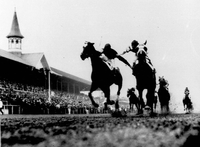| Test Your Eye for Horse Conformation Evaluate and place these three geldings in your order of preference, then see how your choices compare to our expert judge's. Plus, learn how to get your horse into Horse & Rider magazine's next Conformation Clinic.
When I'm judging or evaluating a horse, the first thing I look for is overall balance. A horse that has balanced conformation--with neck, back and hip of equal length--will generally be a good mover and that translates into good performance. A horse that exhibits correct conformation should be a natural athlete. An overabundance of muscling is the last thing I look for. Excessive bulk can cause soundness problems. Muscle mass and conditioning don't change a horse's basic structure. I want to see a horse that's structurally correct, pretty, and balanced -- that's the type of horse that can win a halter class and go on to do well in performance classes. At first glance, I look for a pretty head -- one with small ears, that's broad between the eyes. A clean, slender throatlatch will make it easier for a horse to flex at the poll and work with his head at the proper angle. Next, my eyes go to a horse's topline and shoulder. Everything hangs on the quality of a horse's shoulders and back. The slope, or angle, of a horse's shoulder determines the length of his neck and back and also the way his front legs are set onto his body. Together these attributes contribute to length of stride and balance. The back is the "hub" of a horse, and a short, strong back is essential to a horse staying sound and performing well. Distinct withers of medium height will help keep a saddle in place. From there, I work my way back and down. I like a croup without too much angle; a steep croup can mean a weak hip and incorrect set (angulation) to the horse's hocks. I like to see a long, strong hip with adequate muscling and low hocks. These attributes usually indicate a horse that can stop well and will naturally work off his hind end -- making him a stronger athlete. And when a horse's shoulders and hips are of equal angulation, it means he'll be able to collect himself well and travel correctly. FIRST: HORSE A
This gelding has a good shoulder with nice, pronounced withers that will hold a saddle well. He also appears to have a strong back, and his neck, back and hip are of relatively equal length. While his croup is long enough, its angle is slightly steep, giving his hindquarters a pointed appearance. However, he has adequate hindquarter muscling, both in his hip and gaskin, which should give him the power to perform well. This horse is very nice and square. He has straight legs, with a good, low hock set. His conformation indicates he's an athlete that can handle a lot of work. Overall, he's a nice horse to look at, and despite his few problems, he should be a good performer. SECOND: HORSE B
Horse B's shoulder has a nice slope and overall angle, indicating he should have a decent stride. But he lacks muscling in the shoulder and forearm, some of which may be due to lack of condition; this gives him the appearance of being weak in his front end. His back is acceptable, but his croup is much too short, which makes him inadequately muscled in his hip. This will affect his performance, as he won't have the power needed to drive from behind. When we look at his legs, he has a nice angle to his pasterns, and his legs appear good and straight. Overall, I'd like to see this horse in better condition, with more weight and muscle and less belly. THIRD: HORSE C
As we move to his legs, we find front pasterns that are too steep. When combined with his straight shoulder, he'll have a shorter stride and not as much "shock absorption" as a horse with more normally sloped pasterns. Conformation such as this often leads to soundness problems. The ideal slope of the pastern and shoulder is between 45 and 50 degrees. This gelding also is too high in his hocks, which will prevent him from getting his rear legs under his body to stop well. This, combined with light hindquarter muscling, will reduce his ability to drive strongly from his hind end. Overall, I wouldn't expect Horse C to be as good a performer as the first two horses. Tim Finkenbinder is an accredited judge with the American Quarter Horse Association, American Paint Horse Association, Palomino Horse Breeders of America and the National Snaffle Bit Association. He has served as a judge for the AQHA World Show, the American Quarter Horse Youth Association World Show, the All American Quarter Horse Congress, the NSBA Breeders Championship Show and many major circuits and futurities. Tim has owned or exhibited world champions in Quarter Horse, Paint, Palomino and Appaloosa competition.
|
| Find this article at: http://www.equisearch.com/horses_care/health/anatomy/conformationclinic_070704 |
Trackback URL : 이 글에는 트랙백을 보낼 수 없습니다
Trackback RSS : http://www.fallight.com/rss/trackback/1337
Trackback ATOM : http://www.fallight.com/atom/trackback/1337













